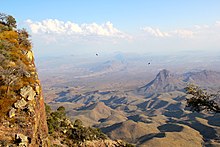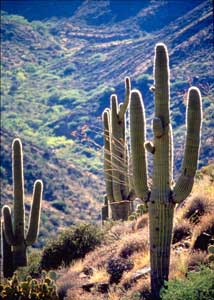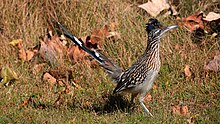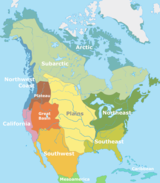Aridoamerica

Aridoamericadenotes aculturalandecological regionspanningNorthern Mexicoand theSouthwestern United States,defined by the presence of the drought-resistant, culturally significantstaple food,thetepary bean(Phaseolus acutifolius).[1]Its dry, arid climate and geography stand in contrast to the verdantMesoamericaof present-day central Mexico into Central America[2]to the south and east, and the higher, milder "island" ofOasisamericato the north. Aridoamerica overlaps with both.[1]
Because of the relatively hard conditions, thepre-Columbianpeople in this region developed distinct cultures and subsistence farming patterns. The region has only 120 mm (4.7 in) to 160 mm (6.3 in) of annual precipitation. The sparse rainfall feeds seasonalcreeksand waterholes.[3]
The term was introduced by American anthropologistGary Paul Nabhanin 1985,[4]building on prior work by anthropologistsA. L. KroeberandPaul Kirchhoffto identify a "true cultural entity" for the desert region. Kirchhoff first introduced the term 'Arid America' in 1954, and wrote: "I propose for that of the gatherers the name 'Arid America' and 'Arid American Culture,' and for that of the farmers 'Oasis America' and 'American Oasis Culture'".[5]
Mexican anthropologistGuillermo Bonfil Batallanotes that although the distinction between Aridoamerica and Mesoamerica is "useful for understanding the general history of precolonial Mexico," that the boundary between the two should not be conceptualized as "a barrier that separated two radically different worlds, but, rather, as a variable limit between climatic regions." The inhabitants of Aridoamerica lived on "an unstable and fluctuating frontier" and were in "constant relations with the civilizations to the south."[6]
Subsistence[edit]


TheChichimeca,an umbrella term for several tribes used by theNahua people,werehunter-gatherersin Aridoamerica grasslands. They gatheredmagueys,yucca flowers,mesquitebeans,chia seeds,andcacti,including the paddles of fruits ofnopalcactus. Thecentury plant(Agave americana) is a particularly important resource in the region.[7]
Despite dry conditions, Aridoamerica boasts the greatest diversity of wild and domesticated tepary beans (Phaseolus acutifolius) and is a possible site of their domestication.[1]Maizecultivation reached Aridoamerica by about 2100 BCE.[8]Archaeologists disagree whether the plant was introduced byUto-Aztecanmigrants from Mesoamerica or spread either northward or southward from other groups by cultural borrowing.[8]
InBaja California,fishing and hunting provided food, as did harvesting acorns, nopal,pine nuts,and other native plants.[9]
Historically, people of Aridoamericacoppicedwillows, that is, tree trunks were cut to a stump to encourage the growth of slender shoots. These willow shoots were woven tightly to produce waterproof, cooking baskets. Fire-heated rocks were plunged into a gruel in the baskets to cook.[3]
Deserts[edit]

The elevation in theChihuahuan Desertvaries from 1970 to 5500 feet, as there are several smaller mountain ranges contained in the area, namely theSan Andres,Doña Anas,andFranklin Mountains.The Chihuahuan is a "rain shadow"desert, formed between two mountain ranges (theSierra Madre Occidentalon the west and theSierra Madre Orientalon the east) which block oceanic precipitation from reaching the area.[10]The Chihuahuan Desert is considered the "most biologically diverse desert in the Western Hemisphere and one of the most diverse in the world", and includes more species of cacti than any other desert in the world.[11]The most prolific plants in this region are agave, yucca, and creosote bushes,[12]in addition to the ubiquitous presence of various cacti species.

When people think of the desert southwest, the landscape of theSonoran Desertis what mostly comes to mind.[12]The Sonoran Desert makes up the southwestern portion of the Southwest. Rainfall averages between 4–12 inches per year, and the desert's most widely known inhabitant is thesaguaro cactus,which is unique to the desert.[13][14]It is bounded on the northwest by the Mojave Desert, to the north by the Colorado Plateau and to the east by theArizona Mountains forestsand the Chihuahuan Desert.[15]Aside from the trademark saguaro, the desert has the most diverse plant life of any desert in the world,[13]and includes many other species of cacti, including the organ-pipe, senita, prickly pear, barrel, fishhook, hedgehog, cholla, silver dollar, and jojoba.[13][14]
The most northwest portion of Aridoamerica is covered by theMojave Desert.In terms of topography, the Mojave is very similar to theGreat Basin Desert,which lies just to its north.[12]The Mojave gets less than six inches of rain annually, and its elevation ranges from 3000 to 6000 feet above sea level.[16]The most prolific vegetation is the tallJoshua tree,which grow as tall as 40 feet, and are thought to live almost 1000 years.[14]Other major vegetation includes the Parry saltbush and the Mojave sage, both only found in the Mojave, as well as the creosote bush.[17]
Wildlife[edit]

The region has an extremely diverse bird population, with hundreds of species being found in Aridoamerica. In theChiricahua Mountainsalone, in southeastern Arizona, there can be found more than 400 species. Species includeCanada(Branta canadensis) andsnow geese,sandhill cranes(Grus canadensis),[18]and theroadrunner,the most famous bird in the region.[19]Birds of prey include thered-tailed hawk(Buteo jamaicensis),Cooper's hawk(Accipiter cooperii),osprey(Pandion haliaetus),golden eagle(Aquila chrysaetos),Harris's hawk(Parabuteo unicinctus),[20]common black hawk(Buteogallus anthracinus),zone-tailed hawk(Buteo albonotatus),bald eagle(Haliaeetus leucocephalus),Swainson's hawk(Buteo swainsoni),American kestrel(Falco sparverius),prairie falcon(Falco mexicanus),peregrine falcon(Falco peregrinus),[21]gray hawk(Buteo plagiatus),[22]barn owl(Tyto alba), thewestern screech owl(Megascops kennicottii),whiskered screech-owl(Megascops trichopsis),great horned owl(Bubo virginianus),long-eared owl(Asio otus),elf owl(Micrathene whitneyi),ferruginous pygmy-owl(Glaucidium brasilianum), andburrowing owl,(Athene cunicularia).[23]among many others.[24]
Other bird species include theturkey vulture(Cathartes aura) andblack vulture(Coragyps atratus);[25]thenorthern cardinal(Cardinalis cardinalis) and its close relative thepyrrhuloxia(Cardinalis sinuous); theblue grosbeak(Passerina caerulea)[26]andblack-headed grosbeak(Pheucticus melanocephalus); thevaried bunting(Passerina versicolor),house finch(Carpodacus mexicanus), andlesser goldfinch(Spinus psaltria);[27]thebroad-billed hummingbird(Cynanthus latirostris),black-chinned hummingbird(Archilochus alexandri),Costa's hummingbird(Calypte costae),[28]Anna's hummingbird(Calypte anna),Rivoli's hummingbird(Eugenes fulgens),blue-throated mountain-gem(Lampornis clemenciae), andlucifer hummingbird(Calothorax lucifer); and theGambel's quail(Callipepla gambelii),[29]common raven(Corvus corax),[30]Gila woodpecker(Melanerpes uropygialis),gilded flicker(Colaptes chrysoides),[31]cactus wren(Campylorhynchus brunneicapillus),rock wren(Salpinctes obsoletus),[32]and many oriole (Icterus), thrasher (Toxostoma), gnatcatcher (Polioptila), dove (Columbidae), rail (Rallidae), and tyrant-flycatcher (Tyrannidae) species.[24]
Mammal species include thebobcat(Lynx rufus),coyote(Canis latrans),collared peccary(Pecari tajacu),black bear(Ursus americanus),black-tailed jackrabbit(Lepus californicus),desert cottontail(Sylvilagus audubonii),desert bighorn sheep(Ovis canadensis nelsoni),mule deer(Odocoileus hemionus), Coues'white-tailed deer(Odocoileus virginianus couesi),elk(Cervus canadensis),feral horse(Equus caballus),ringtail(Bassariscus astutus),gray fox(Urocyon cinereoargenteus),kit fox(Vulpes macrotis),mountain lion(Puma concolor),river otter(Lontra canadensis),long-tailed weasel(Neogale frenata),western spotted skunk(Spilogale gracilis),pronghornantelope (Antilocapra americana),raccoon(Procyon lotor), numerouskangaroo rat(Dipodomys),woodrat(Neotoma), andpocket mouse(Chaetodipus) species,white-nosed coati(Nasua narica),jaguar(Panthera onca), andMexican wolf(Canis lupus baileyae). There is also a great diversity ofbatspecies in the region.[33]
There is a large contingent of snakes native to the region. Among them include: therosy boa(Lichanura trivirgata); several sub-species of theglossy snake(Arizona elegans); theTrans-Pecos ratsnake(Bogertophis subocularis); several sub-species of shovel-nosed snakes; several sub-species of kingsnake, including thedesert kingsnake(Lampropeltis getula splendida) and theArizona mountain kingsnake(Lampropeltis pyromelana); theArizona coral snake(Micruroides euryxanthus); thewestern diamondback rattlesnake(Crotalus atrox); theTrans-Pecos copperhead(Agkistrodon contortrix pictigaster); theSonoran sidewinder(Crotalus cerastes cercobombus); theArizona black rattlesnake(Crotalus oreganus cerberus); thewestern rattlesnake(Crotalus viridis); theGrand Canyon rattlesnake(Crotalus oreganus abyssus), found only in Arizona; several sub-species of theridge-nosed rattlesnake(Crotalus willardi), and thedesert massasauga(Sistrurus catenatus edwardsii).[34]
Other reptiles in the region include lizards and turtles. Lizards are highly represented in the region, the most distinctive denizen being theGila monster,native only to the American Southwest and the state of Sonora in Mexico. Other lizards include:Sonoran collared lizard(Crotaphytus nebrius); several types of geckos, includingwestern banded gecko(Coleonyx variegatus), the barefoot banded gecko (Coleonyx switaki), and the Mediterranean house gecko (Hemidactylus turcicus), the latter species being non-native to the region and confined to developed areas; thedesert iguana(Dipsosaurus dorsalis); thechuckwalla(Sauromalus ater); thegreater earless lizard(Cophosaurus texanus scitulus); several sub-species ofhorned lizards(Phrynosoma); numerous species ofspiny lizards(Sceloporus);Gilbert's skink(Plestiodon gilberti); thewestern skink(Plestiodon skiltonianus);Trans-Pecos striped whiptail(Aspidoscelis inornata heptagrammus); and theArizona night lizard(Xantusia arizonae).[35]Turtles are less numerous than their other reptilian counterparts, but several are found in the region, including: thewestern painted turtle(Chrysemys picta bellii); theRio Grande cooter(Pseudemys gorzugi); thedesert box turtle(Terrapene ornata luteola); theBig Bend slider(Trachemys gaigeae gaigeae); theSonora mud turtle(Kinosternon sonoriense); and thedesert tortoise(Gopherus agassizii).[36]
Amphibians include numerous toads and frogs. Toads which can be found in the region include: theGreat Plains toad(Anaxyrus cognatus); thegreen toad(Anaxyrus debilis); theArizona toad(Anaxyrus microscaphus); theNew Mexico spadefoot(Spea multiplicata stagnalis); and theColorado River toad(Incilius alvarius), also known as the Sonoran Desert toad. Frog representation includes:western barking frog(Craugastor augusti); thecanyon tree frog(Hyla arenicolor); theArizona treefrog(Hyla wrightorum); thewestern chorus frog(Pseudacris triseriata);Chiricahua leopard frog(Lithobates chiricahuensis); and therelict leopard frog(Lithobates onca). There are quite a few salamanders throughout the region, including: theArizona tiger salamander(Ambystoma mavortium nebulosum) and thepainted ensatina(Ensatina eschscholtzii picta).[37]
Political geography[edit]
The current Mexican states that lie in Aridoamerica are:
The northern parts of:
The southern portions of the United States that lie within Aridoamerica are:
Aridoamerica cultures[edit]

- Acaxee
- Aranama(Hanáma,Hanáme,Chaimamé,Chariname,Xaraname,Taraname), coastal Texas
- Caxcane
- Coahuiltecan,Texas, northern Mexico
- Cochimí,Baja California[9][38]
- Cocopá(Cocopah), Baja California[9]
- Comecrudo,Texas, northern Mexico
- Cotoname(Carrizo de Camargo)
- Guachichil
- Guachimontone
- Guamare
- Guaycura,Baja California[9]
- Huarijio[38]
- Huichol[38]
- Jumanos,Texas
- Karankawa,coastal Texas
- Kiliwa,Baja California[9]
- Kumiai(Kumeyaay), Baja California[9]
- La Junta,Texas, Chihuahua
- Mamulique,Texas, northern Mexico
- Manso,Texas, Chihuahua
- Mayo[38]
- Mogollon culture,ca. 200–1500 CE, alsoOasisamerica
- Monqui,Baja California
- Opata
- Otomi
- Pai Pai,Baja California[9]
- Pame
- Pericúe(Pericú), Baja California[9]
- Pima Bajo,[38]Chihuahua and Sonora
- Quems,Coahuila and Texas
- Solano,Coahuila and Texas
- Seri[38]
- Tamique,Texas
- Tarahumara[38]
- Tecuexe
- Tepecano
- Tepehuán[38]
- Teuchitlan tradition
- Toboso,Chihuahua and Coahuila
- Western Mexico shaft tomb tradition
- Yaqui[38](Yoeme), Arizona, Sonora
- Zacateco
See also[edit]
- Classification of indigenous peoples of the Americas
- Great Mural Rock Art, Baja California
- Mesoamerica
- Oasisamerica
Notes[edit]
- ^abcPratt and Nabhan 419
- ^Cordell and Fowler 85
- ^abBye and Linares 273
- ^Nabhan, G.B. (October 1985)."Native crop diversity in Aridoamerica: Conservation of regional gene pools".Economic Botany.39(4): 387–99.doi:10.1007/bf02858746.S2CID23223873.Retrieved3 July2017.
- ^Paul Kirchhoff, "Gatherers and farmers in the Greater Southwest: a problem in classification", inAmerican Anthropologist,56 (1954) (Special Southwest Issue), pp. 529–50, see map p. 544.
- ^Bonfil Batalla, Guillermo (1996).Mexico Profundo: Reclaiming a Civilization.Translated by Dennis, Philip A. University of Texas Press. pp.9.ISBN9780292708433.
- ^Bye and Linares 256
- ^abHerr, Sara A. "The Latest Research on the Earliest Farmers."Archaeology SouthwestVol. 23, No. 1, Winter 2009, p.1
- ^abcdefghSchmal, John P."Indigenous Baja".History of Mexico.Houston Institute for Culture.Retrieved16 November2015.
- ^"The Chihuahuan Desert".New Mexico State University. Archived fromthe originalon December 27, 2012.RetrievedJuly 6,2015.
- ^"Chihuahuan Desert".National Park Service.RetrievedJuly 6,2015.
- ^abc"Deserts of Southwest USA".The American Southwest.RetrievedJuly 6,2015.
- ^abc"Southern North America: Southwestern United States into northwestern Mexico".World Wildlife Fund.RetrievedJuly 6,2015.
- ^abcGreen, Kim & Don (October 1, 2001)."The American Southwest; Footsteps of the Ancients Expedition".Lonely Planet.RetrievedJuly 6,2015.
- ^"The Geologic Origin of the Sonoran Desert".Arizona-Sonora Desert Museum.RetrievedJuly 6,2015.
- ^"What & Where is the Mojave Desert?".Digital-Desert.RetrievedJuly 6,2015.
- ^"Mojave Desert".National Park Service.RetrievedJuly 6,2015.
- ^Sharp, Jay W."Looking for Birds in the Southwest".DesertUSA.RetrievedJuly 13,2015.
- ^"Greater Roadrunner".Arizona-Sonora Desert Museum.RetrievedJuly 13,2015.
- ^"Hawks & Eagles".Arizona-Sonora Desert Museum.RetrievedJuly 13,2015.
- ^"Caracaras & Falcons".Arizona-Sonora Desert Museum.RetrievedJuly 13,2015.
- ^"Gray Hawk".Cornell Lab of Ornithology.RetrievedJuly 13,2015.
- ^"Owls".Arizona-Sonora Desert Museum.RetrievedJuly 13,2015.
- ^ab"Observations".
- ^"Vultures".Arizona-Sonora Desert Museum.RetrievedJuly 13,2015.
- ^"Cardinals & Grosbeaks".Arizona-Sonora Desert Museum.RetrievedJuly 13,2015.
- ^"Finches".Arizona-Sonora Desert Museum.RetrievedJuly 13,2015.
- ^"Hummingbirds".Arizona-Sonora Desert Museum.RetrievedJuly 13,2015.
- ^"Quail".Arizona-Sonora Desert Museum.RetrievedJuly 13,2015.
- ^"Common Raven".Arizona-Sonora Desert Museum.RetrievedJuly 13,2015.
- ^"Woodpeckers".Arizona-Sonora Desert Museum.RetrievedJuly 13,2015.
- ^"Wrens".Arizona-Sonora Desert Museum.RetrievedJuly 13,2015.
- ^"Observations".
- ^"Snakes of the American Southwest".Southwestern Center for Herpetological Research. Archived fromthe originalon March 14, 2016.RetrievedJuly 13,2015.
- ^"Lizards of the American Southwest".Southwestern Center for Herpetological Research. Archived fromthe originalon March 14, 2016.RetrievedJuly 13,2015.
- ^"Turtles of the American Southwest".Southwestern Center for Herpetological Research. Archived fromthe originalon July 13, 2015.RetrievedJuly 13,2015.
- ^"Amphibians of the American Southwest".Southwestern Center for Herpetological Research. Archived fromthe originalon March 14, 2016.RetrievedJuly 13,2015.
- ^abcdefghi"Mexico: Map".Ethnologue.Retrieved16 November2015.
References[edit]
- Robery A. Bye;Edelmira Linares (2007)."9".In Carrasco, David (ed.).Cave, City, and Eagle's Nest: An Interpretive Journey through the Mapa de Cuauhtinchan No. 2.Albuquerque: University of New Mexico. pp. 255–280.ISBN978-0-8263-4283-6.Retrieved16 November2015.
- Cordell, Linda S. and Don D. Fowler, eds.Southwest Archaeology in the Twentieth Century.Salt Lake City: University of Utah Press, 2005.ISBN978-0-87480-825-4.
- Richard C. Pratt;Gary Paul Nabhan (1988). Gepts, Paul (ed.).Genetic Resources of Phaseolus Beans: Their maintenance, domestication, evolution and utilization.Springer. p. 419.ISBN978-94-009-2786-5.Retrieved16 November2015.


